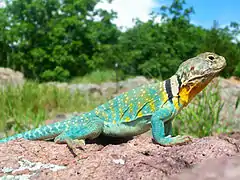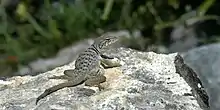Common collared lizard
The common collared lizard (Crotaphytus collaris), also called eastern collared lizard,[2] Oklahoma collared lizard, yellow-headed collared lizard or collared lizard, is a North American species of lizard from the family Crotaphytidae. with a large head and powerful jaws. The name "collared lizard" comes from the lizard's distinct coloration, which includes bands of black around the neck and shoulders that look like a collar. Males can be very colorful, with blue green bodies, yellow stripes on the tail and back, and yellow orange throats.
| Common collared lizard Crotaphytus collaris | |
|---|---|
 | |
| A common collared lizard in Taum Sauk Mountain State Park, Missouri | |
| Scientific classification | |
| Kingdom: | Animalia |
| Phylum: | Chordata |
| Class: | Reptilia |
| Order: | Squamata |
| Suborder: | Iguania |
| Family: | Crotaphytidae |
| Genus: | Crotaphytus |
| Species: | C. collaris |
| Binomial name | |
| Crotaphytus collaris (Say, 1823) | |
| Synonyms | |
| |

Description

Individuals can reach 8–15 in (20–38 cm) in length (including the tail), with a large head and powerful jaws. Males have a blue-green body with a light brown head. Females have a light brown head and body. It is a member of the collared lizard family.
Geographic range and habitat
Chiefly found in dry, open regions of Mexico and the south-central United States including Missouri, Arkansas, Oklahoma, Texas, Arizona, New Mexico, Colorado, and Kansas, the full extent of its habitat in the United States ranges from the Ozark Mountains to Western Arizona.
Cultural Impact
The collared lizard is the state reptile of Oklahoma, where it is known as the mountain boomer. The origin of the name "mountain boomer" is not clear, but it may be traceable to settlers traveling west during the Gold Rush. One theory is that settlers mistook the sound of wind in canyons for the call of an animal in an area where the collared lizard was abundant. In reality, collared lizards are silent.
Behavior
Like many other lizards, including the frilled lizard and basilisk, collared lizards can run on their hind legs, and are relatively fast sprinters. Record speeds have been around 16 miles per hour (26 km/h), much slower than the world record for lizards (21.5 mph or 34.6 km/h) attained by the larger-bodied Costa Rican spiny-tailed iguana, Ctenosaura similis.
Collared lizards in the wild have been the subject of a number of studies of sexual selection. In captivity if two males are placed in the same cage they will fight to the death.
Notes
- "Crotaphytus collaris (Say, 1823)". The Reptile Database. Archived from the original on 2014-10-08. Retrieved 2012-02-16.
- Stebbins, R.C. 2003. A Field Guide to Western Reptiles and Amphibians, Third Edition. The Peterson Field Guide Series. Houghton Mifflin. Boston and New York. xiii + 533 pp. ISBN 0-395-98272-3. (Crotaphytus collaris, pp. 271-272 + Plate 27 + Map 85.)
References
| Wikispecies has information related to Crotaphytus collaris. |
| Wikimedia Commons has media related to Crotaphytus collaris. |
- Bonine, K. E.; Garland, Jr., T. (1999). "Sprint performance of phrynosomatid lizards, measured on a high-speed treadmill, correlates with hindlimb length" (PDF). Journal of Zoology. London. 248 (2): 255–265. doi:10.1111/j.1469-7998.1999.tb01201.x.
- Garland, Jr., T. (1984). "Physiological correlates of locomotory performance in a lizard: an allometric approach" (PDF). Am. J. Physiol. 247 (Regulatory Integrative Comp. Physiol. 16): R806–R815.
- Husak, J. F.; Fox, S. F. (2006). "Field use of maximal sprint speed by collared lizards (Crotaphytus collaris): compensation and sexual selection". Evolution. 60 (9): 1888–1895. doi:10.1111/j.0014-3820.2006.tb00532.x. PMID 17089973. S2CID 2024684.
- Husak, J. F.; Fox, S. F.; Lovern, M. B.; Van Den Bussche, R. A. (2006). "Faster lizards sire more offspring: sexual selection on whole-animal performance". Evolution. 60 (10): 2122–2130. doi:10.1111/j.0014-3820.2006.tb01849.x. PMID 17133868. S2CID 23623265.
- Lappin, A. K.; Brandt, Y.; Husak, J. F.; Macedonia, J. M.; Kemp, D. J. (2005). "Gaping displays reveal and amplify a mechanically based index of weapon performance". American Naturalist. 168 (1): 100–113. doi:10.1086/505161. JSTOR 3844679. PMID 16874617. S2CID 4823496.
- Snyder, R. C. (1962). "Adaptations for bipedal locomotion of lizards". Am. Zool. 2 (2): 191–203. doi:10.1093/icb/2.2.191.
- Drake, E. C. (1999). Information on the Collared Lizard.
Two black stripes around the neck give these lizards their name.
